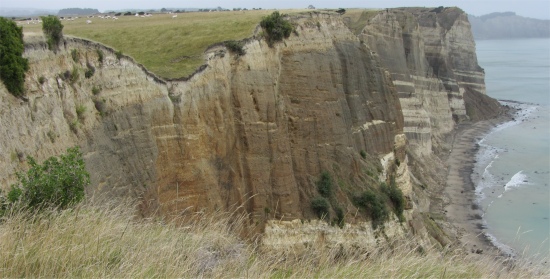
Three Fault Lines at Cape Kidnappers - Look at the Disjointed Strata
|
The incessant whacking of large rain drops falling overnight from the tree above my pitch in the campsite was a form of Chinese water torture. The first thing I did when I arose was arrange for a different pitch on site.
It was a miserable start to the day, the rain and mist seemed to penetrate and cling to everything. I had a chat in the rain, as you do, with my English neighbours. They had toured Northland 11 years ago, and had totally enjoyed it. Now they were visiting their son and his wife, and also doing a whistle-stop tour of the rest of the North Island and the South Island in just a few weeks, which was nigh on impossible they now realised.
"We came down from Rotorua, and it was baking up there yesterday," said the woman. "Yeah, the rain keeps following me around," I joked with her. "Let us know where you are heading and we'll avoid it," piped up her husband.
Their son had bought a place near Christchurch, which his parents described as nothing better than a beach-hut. Despite that, their son loved the country, but his wife had ambitions of returning back to Britain at some point. The son had developed the strategy of buying lots of material goods with the hope of persuading his wife that they couldn't possibly return and leave everything they had bought behind. "That strategy won't hold water," I laughed, and they joined in with me, knowing I was telling the truth. We shared travel experiences before they headed off to find sunnier climes.
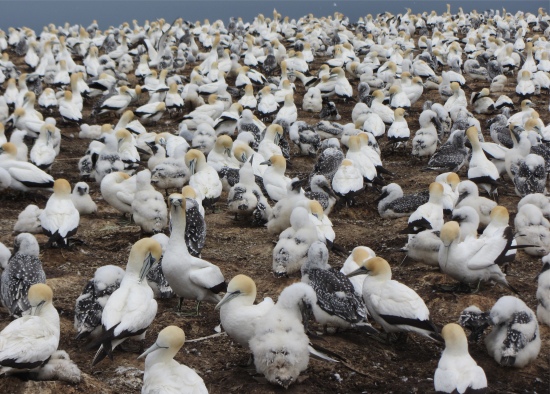
Plateau Gannet Colony
|
It was too wet to walk around Napier all day, so I booked myself onto a gannet safari. To kill time before the safari started, I headed up to Bluff Hill, once a gun emplacement during World War II, butted onto the north of the parade. Up-market properties lined the winding streets that nuzzled onto the hillside, but I was informed that these were not a match for the grand views over Hawke's Bay to be had from the Bluff Hill Domain Lookout on the eastern summit. Sadly, most of Hawke's Bay was hidden behind cloud and rain.
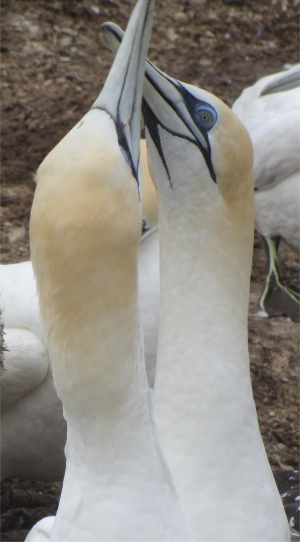
Paired Adults Greeting Each Other
|
However, I did get a splendid view overlooking Napier Port. A small mountain of containers lay at one end of the port, and two large cranes were slowly removing more containers from a large ship to add to this mountain. The other side of the port had its small mountain of timber awaiting a ship to ferry it away. A large bulk carrier was berthed, and judging by the yellow stains around it, it might have been carrying sulphur. To add to the variety, and looking slightly out of place amongst the timber and phosphoric acid tanks, a cruise ship was berthed.
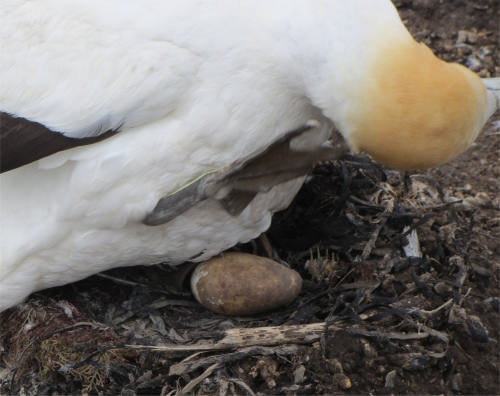
Glimpse of a Gannet Egg
|
I got chatting with a Canadian couple walking along the lookout. "Where abouts in Canada are you from?" I asked. "Ontario," they said. "Where in Ontario?" I asked again. "Kingston," was the reply. "Ah, so you are near the Rideau Canal," I said, trying to get the conversation going. They were impressed that I knew that area of Ontario, and the conversation picked up. "We live there, but we don't really, we live everywhere," said the chap. "We have a large RV based there, but we spend most of our time travelling. We passed all out heirlooms on to the children, then passed on to the church what they wanted, and the rest we just sold. Then we sold our house," added the chap. They had also lived on a boat for a while, and had done quite a bit of sailing, including one aborted attempt to sail the Atlantic. As their sailing exploits were rolled out to me, they freely admitted that they were not experienced sailors, and I learned of a few calamities they had suffered. It was probably a wise decision not to tackle the Atlantic. I admired them for taking on this alternative lifestyle, but they had that nagging doubt in the back of their minds that when they were old they might want a place to call home again. They had reached their seventies now, so the prospect was looming. We wished each other safe journey, and we became memories.
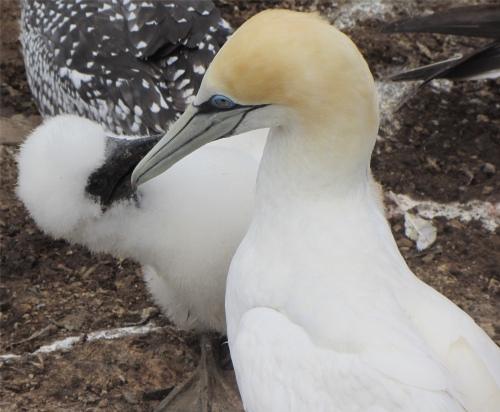
Chick Telling Adult He Wants Food by Rubbing Beaks
|
Cape Kidnappers was my next port of call. I would be reaching there via the overland gannet safari. In the days when Cook was exploring these waters, local Maori tried to kidnap his Tahitian servant boy. The attempt was thwarted, but the name stuck.
Near Te Awanga, I and a few other souls met up in a car park, where a 4WD bus picked us up. The route took us through private land belonging to the Summerlee Station. The station seemed to hold thousands of sheep and about 400 Aberdeen Angus cows. An American multimillionaire, Julian Robertson, had one of his many mansions on the land, together with umpteen lodges, a restaurant, library etc. plus a golf course. Folk who had more money than sense could stay in the lodges, or in Julian's mansion, or play golf for exorbitant fees.
The whole section of land is fenced off, and an inner section has a high electrified fence stretching for kilometres to act as an extra deterrent against vermin predators. Abundant evidence lay around in the form of traps set to catch the vermin, and the area in which the gannet colonies were to be found was more-or-less predator free.
Our driver gave us a running commentary as we drove along a gravel track, pointing out harriers, Australian magpies, various trees which had sprung up after land had been cleared many years ago, and the effects of on-going erosion which were still visible. As we passed a small creek, a black shag, one of the cormorant family, was standing on a spit of pebbles with its wings outstretched. Cormorants don't possess oils to keep their feathers waterproofed, so they periodically have to stand with their wings outstretched to help them dry. On the way across the cliff tops, we stopped to look along the line of cliffs which stretched towards Napier. From the disjointed strata in the cliff walls, we could clearly see three fault lines over a short distance along the cliffs, confirming that the cape sits over a major fault line.
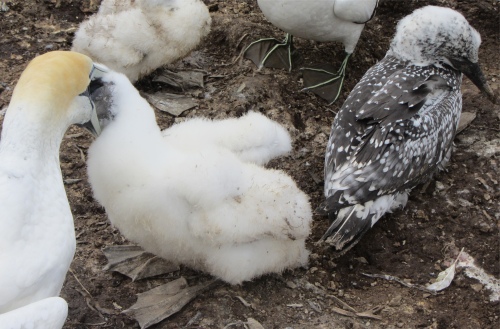
Chick and Juvenile
|
Our guide commented about the Japanese earthquake which happened in the not too distant past, and mentioned how the whole of Japan had shifted by 2.4m. That is a colossal amount of energy expended. He stated that the earth's tilt had been affected. Normally it would spring back, but on this occasion it hadn't. All the GPS satellites had to be tweaked at the time to take this into consideration. There is a huge fault that stretches out to the Chatham Islands, and if an earthquake occurs along this fault, then the resulting tsunami will devastate this region. "The Napier earthquake in 1931 raised a lot of the land that is now used by Napier for its airport," I said. He underlined the statement by saying how Bluff Hill had been an island up until that point.
We carried on to the gannet colony, with yet more commentary from our guide. He had lived out here all his life and had worked on the land, so he was the ideal fellow really.
As we approached the colony over a steep rise, I could see far below tractors which were used to haul carriages of people along the beach at low tide. This mode of transport had been fully booked when I made my enquiries, which was perhaps a good thing in hindsight, since the folk who arrived by the beach had to climb all the way to the tops of the cliffs on foot.
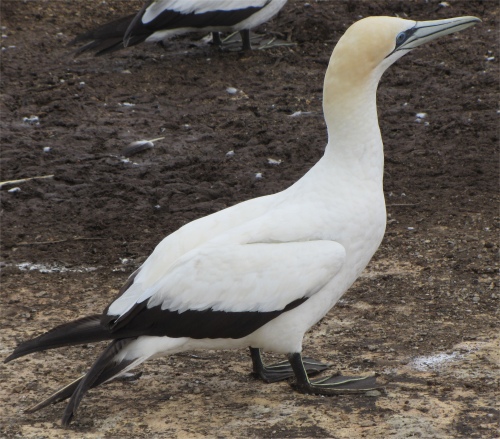
Adult Gannet
|
When we drove up a final rise, we were suddenly upon hundreds of gannets, all scattered around a muddy piece of ground where they had their nests. The smell was overpowering, but the sight spectacular, and the squawking rather loud. The four colonies at Cape Kidnappers are the largest on mainland New Zealand. An estimated 4000 live in this Plateau Colony where I stood, with 4700 birds in the Saddle Colony below the lighthouse. A further 3500 inhabit the Black Reef Colony and the same again at the inaccessible Whalebone Reef Colony. Gannets had been nesting here since the 1870s.
The adult birds were quite pretty, with a yellow hue on their heads, blue eyes, white plumage with black tips to their wing feathers, and green/yellow markings running radially along their webbed feet.
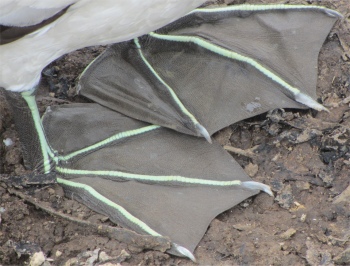
Gannet Smart Shoes
|
The adults arrive at Cape Kidnappers around July to begin courtship and nest building. Only one egg is laid, and the pale blue eggs take about 6 weeks to hatch, though the colour soon gets disguised to a brown hue since the adults often use their webbed feet, which have veins running through them, to keep the eggs warm. The chicks arrive in early November naked and grey, and will live at this colony for about 15 weeks. In this time it will change to a white fluffy month-old chick, and then by 3 months, it will have become a grey and speckled juvenile. At flying age the average chick will weigh 50 times its 60 gram birth weight.
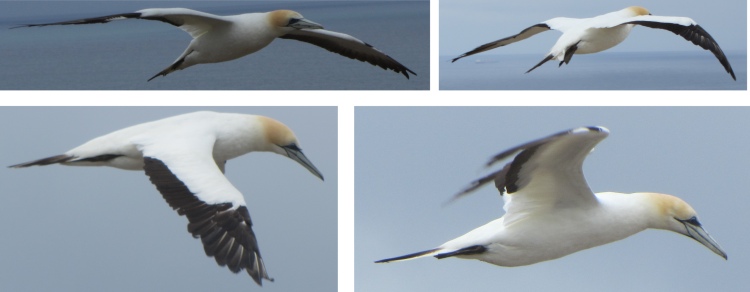
Gannets in Flight
|
The adults will take turns at incubating and staying with the chick, while the other goes off in search of food. Eventually both adults go off to bring food back to the chick, and if the chick strays too far from the nest, it will be bullied by other birds. I saw some evidence of that taking place. The chicks become larger than their parents, usually by about 1kg, which is stored as fat. By this stage the young are stretching their wings, it is the only exercise they get before their long migration. In March, the birds will start their migration, the young's first flight will be to the Great Barrier Reef 2600km away, all on the fat reserves accumulated. It takes them about 8 days to get there. 70-80% of these birds will die over the next 2-3 years before they have a chance to return to Cape Kidnappers. Despite the high fatality rate, the colonies are growing by 3% per annum.
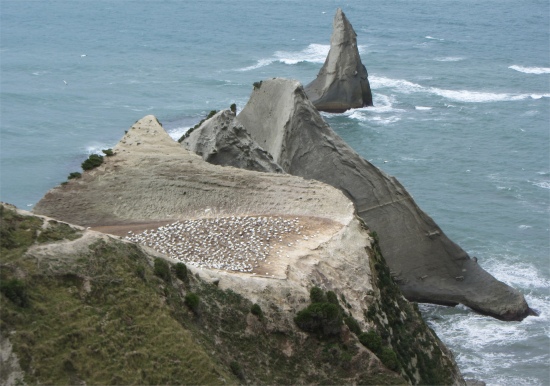
Saddle Colony
|
Most gannets will not breed until they are at least 4 or 5 years old. A group sitting apart from the rest of the colony comprised adolescents (2-4 year olds) who had not yet pair bonded or mated. When they do mate it is often for life. Gannets may live as long as 33 years, though 25 years is the average lifespan.
Paired gannets rub their beaks and necks together, preen head feathers, bow and call to each other. These displays are performed during courtship and when a partner returns home to its nest site. Lone gannets swinging their heads from side to side and bowing their beaks beneath their wings, are giving a "solo bowing" display, which may be a case that the gannet on its territory is feeling threatened by another bird. Males may perform this most intensely when a female gannet (not its partner) calls or lands nearby.
As for food, gannets eat live fish, in particular herrings, pilchards, mullet, saury, garfish, anchovies, and squid. Their soaring flight will be broken off as they spot a school of fish. They plummet up to 30m to hit the water at speeds up to 140kph, the impact cushioned by air sacs in the forehead, neck and chest wall. They then swim down, sometimes by as much as 30m, catch a fish and swallow it on the surface, all in a few seconds. The gannet may spend up to 15 hours away from the nest while feeding. Chicks are fed on demand, but usually near dawn and dusk.
It was a marvellous spectacle seeing all these birds so close up, and they were entirely unfazed by our presence. They would swoop into the wind, slow down to a hover over their nest, and drop gracefully, then go through the beak and neck rubbing rituals with their partner. If it had come back with food for its chick, the chick would rub its beak along the parent's beak, which would stimulate the parent to open its beak so as to engulf the chick's beak, and fish would be transferred from adult to young.. There were many fluffy chicks and juveniles. One adult still sat on an egg, but our guide said that the egg was probably infertile and would never hatch. I felt privileged to have been able to stand so close and observe this grand colony. Its numbers would almost double in the evening when all the adults returned from their fishing trips.
All good things come to an end, and soon we were bumping back along the gravel road back to where we had deposited our cars. Despite the occasional shower during our visit to see the gannets, it had been a very informative and enjoyable day.

